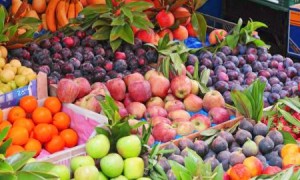The Best Way to Wash Fruits and Vegetables
You’ve probably been washing your produce all wrong. Here’s the right way to do it so you can minimize the opportunity of some nasty illnesses
BY PAIGE FOWLER Friday, October 16, 2015
Your vegetable drawer is the filthiest part of your refrigerator.
“Even if you washed every piece of produce before storing it, bacteria can still grow as foods spoil or things leak down in there,” says Sandria Godwin, Ph.D., professor in the College of Agriculture, Human and Natural Sciences at Tennessee State University. “Some bacteria can survive in the drawer for weeks.”
So how do you get your produce clean enough to eat? Running them under the tap for a few seconds isn’t enough. Follow these steps to completely wash away the filth, dirt, and pesticides before you take a bite.
How to store: Keep your fruit and vegetables in the grocery-store plastic bags instead of placing them directly in the bin—just be sure to loosen the bag to allow moisture to escape and prevent mold growth, Godwin says.
How to rinse: Godwin and a team of researchers at TSU found that properly cleaning produce can remove most bacteria—as long as you do it right.
You should hold your produce under cold running water for 30 to 60 seconds. Sure, that seems like a ridiculously long time to wash, say, one tomato, but putting in the effort will lower your risk of ingesting bacteria or germs that can lead to illness or—in some extreme cases—death.
And don’t get suckered into buying an expensive vegetable wash or making a homemade solution. “Plain old water works,” says Godwin.
How to scrub: “While rinsing, use your hands to scrub the skin, which helps release bacteria so it washes away more easily,” she says.
Gently rub soft fruits or vegetables with the palms of your hands. Don’t rub so hard you cause bruising. For firm produce, you can use a vegetable brush.
A clean toothbrush can also come in handy tackling tight crevices of broccoli and cauliflower, and for cleaning the core or the bottom of an apple where most microbes hang out. Let it air dry between uses, and toss it in the dishwasher to clean.
And scrub the outside of pineapples, oranges, and melons even if you plan to peel them. “When you cut into these foods with a knife, bacteria on the outside gets transferred to the inside, which can make you sick,” Godwin explains.
How to soak: “Most fruits and vegetables don’t need to soak,” she says. Those that do: leafy greens such as kale, chard, and spinach because dirt can firmly cling to the leaves.
“Soak the bunch in a bowl of clean water for several minutes and then dry it with a salad spinner,” she says. In her research, rinsing and soaking produce removed up to 98 percent of bacteria.
BY PAIGE FOWLER Friday, October 16, 2015
Your vegetable drawer is the filthiest part of your refrigerator.
“Even if you washed every piece of produce before storing it, bacteria can still grow as foods spoil or things leak down in there,” says Sandria Godwin, Ph.D., professor in the College of Agriculture, Human and Natural Sciences at Tennessee State University. “Some bacteria can survive in the drawer for weeks.”
So how do you get your produce clean enough to eat? Running them under the tap for a few seconds isn’t enough. Follow these steps to completely wash away the filth, dirt, and pesticides before you take a bite.
How to store: Keep your fruit and vegetables in the grocery-store plastic bags instead of placing them directly in the bin—just be sure to loosen the bag to allow moisture to escape and prevent mold growth, Godwin says.
How to rinse: Godwin and a team of researchers at TSU found that properly cleaning produce can remove most bacteria—as long as you do it right.
You should hold your produce under cold running water for 30 to 60 seconds. Sure, that seems like a ridiculously long time to wash, say, one tomato, but putting in the effort will lower your risk of ingesting bacteria or germs that can lead to illness or—in some extreme cases—death.
And don’t get suckered into buying an expensive vegetable wash or making a homemade solution. “Plain old water works,” says Godwin.
How to scrub: “While rinsing, use your hands to scrub the skin, which helps release bacteria so it washes away more easily,” she says.
Gently rub soft fruits or vegetables with the palms of your hands. Don’t rub so hard you cause bruising. For firm produce, you can use a vegetable brush.
A clean toothbrush can also come in handy tackling tight crevices of broccoli and cauliflower, and for cleaning the core or the bottom of an apple where most microbes hang out. Let it air dry between uses, and toss it in the dishwasher to clean.
And scrub the outside of pineapples, oranges, and melons even if you plan to peel them. “When you cut into these foods with a knife, bacteria on the outside gets transferred to the inside, which can make you sick,” Godwin explains.
How to soak: “Most fruits and vegetables don’t need to soak,” she says. Those that do: leafy greens such as kale, chard, and spinach because dirt can firmly cling to the leaves.
“Soak the bunch in a bowl of clean water for several minutes and then dry it with a salad spinner,” she says. In her research, rinsing and soaking produce removed up to 98 percent of bacteria.
source: www.menshealth.com



Comments
Post a Comment